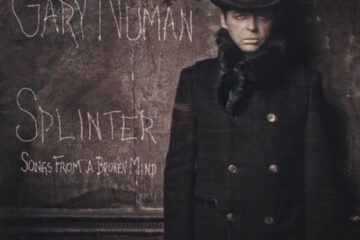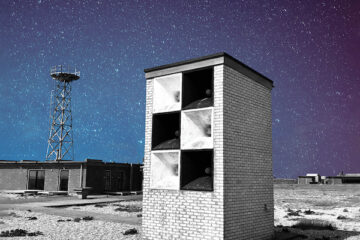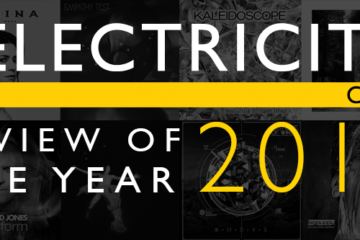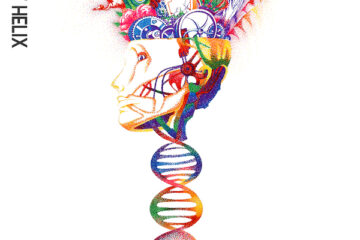Synth mathematics…
It can take years or even decades, to realise the true value of the many instrumental treasures that have by default, been archived over time. In this case, it’s the re-emergence of guitarist Robin Simon, who now steps up alongside the regular collaborators that are John Foxx and the Maths on their latest 2020 release – Howl.
Dennis Leigh, aka, John Foxx, is synonymous with the artful electronic; he’s hiked the path from Tiger Lily to Ultravox, and beyond, showcasing a fine pedigree along the way.
The quick shutter speeds that went some way to define those historic moments in time, had also opened the aperture to the likes of John McGeoch (Visage, Magazine) and Keith Levine (Public Image Ltd), while Foxx-era Ultravox set their own crossfade into a new era of post-punk avant-garde guitar tones that provided an unscheduled, and perhaps unanticipated prompt to the coming new dawn of Synth Britannia – a perfect juxtaposition, that in some cases, demonstrated a transition from unbridled synth-rock into a more commercially viable brand of synth-pop.
Treading the boards back through the decades, Robin Simon’s sense of innovation would also see him forge the use of synthesizers through guitar effects pedals – a technique that the likes of Gary Numan would carry forward, while he would also encourage Ultravox’s Chris Cross in the use of synthesized bass parts.
Flash forward then, to 2020’s Howl. It portrays a fitting exposition – effortlessly setting the template for a nostalgic re-take on the aforementioned post-punk-styled, angst-driven guitars that often unleash their discordant energies, and all of which are shaped into something spectacularly individual. And not only that, this latest release goes some way to prompting an emotional hark back to the recordings that provided part of the canvas for Robin Simon’s identity – i.e. his association with Ultravox’s Systems of Romance album. Today, his sound contributes to a vibrant brand of evocative when coupled with the engaging younger wave of talent that is Benge and Hannah Peel.
Opener ‘My Ghost’ – for me one of the album’s top tracks, definitely shakes the shadows. As robotic as it is melodic, it’s a punk-lively electro offering of blazing intensity, with catchy and multi-layered melodic twists to boot, all punctuated throughout with an addictive jovial synth swathe. The claps and clasps that drive the rhythm render it quick-paced, while the synth layers get more vibrant with every colourful overtone. It resolves in a way that is Odyssey-like, both in sound and in terms of adventure story, settling alongside a contrasting and sophisticated placement of upfront guitar riff, that leaves a distinct yearning for more. Bombastic expression all ending in a perfectly buoyant poise, before finally pulling off its rubber-textured layer one last time.
The album’s title track, ‘Howl’ – released as a single back in May 2020, is in many ways reflective of John McGeoch’s guitar style, therefore deeming it very reminiscent of Magazine and, notably, Visage – think ‘We Move’ from their 1980 debut. The obvious figure that stares back, though, is Systems of Romance-era Ultravox. The guitars drive a rain dance of adolescent post-punk vitality that fuses with the electronic soundscapes, creating a static haven of pent-up energy, that also manages to be very Bowie. It’s novel to hear the dynamism here – it’s like being thrust into the eye of the storm – surrounded by the energetic exploration that those sustained howling guitars provide. Here, no thresholds are defined, instead, the limits are boundless.
‘Tarzan and Jane Regained’ punches to yet another high point, featuring reverberated guitar sounds – Phrygian-sounding with eastern flavours, all appropriately positioned amongst what is a hugely experimental and lengthily exploration – occasionally the guitars and bass casting reflections to Public Image Ltd.’s ‘Theme’. Its dark sounding force is enhanced with a liquid filled, bottom heavy bassline. A progressive stomper of psychedelic influences that exhibits vast deposits – all very Doctor Who in personality, before swarming synths leading to an abrupt finish.
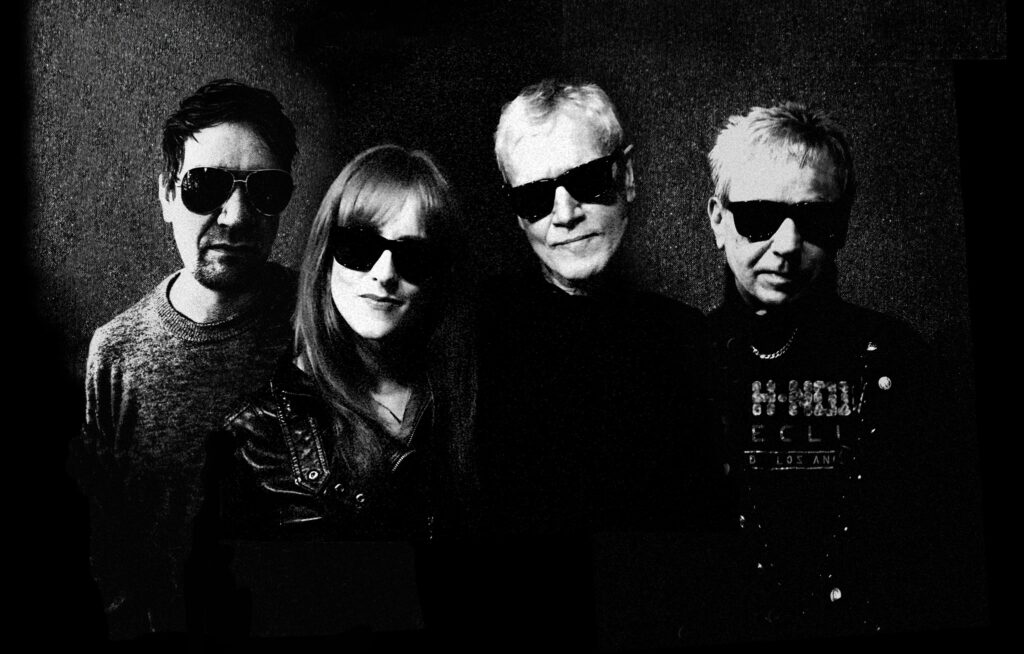
‘The Dance’ portrays elegance and successfully merges an intro of vintage-sounding tremolo effects and beat maps with a more contemporary feel. There’s just the right amount of static atmosphere – very film noir, with consistent cinematic themes that flicker to the fore, presenting the perfect balance of light and shade, and ultimately, beauty. ‘Last Time I Saw You’ offers up complete contrast – a late night power tools composition with volume that assaults every passing place – it delves to great depths and consequently produces echoes out of deep tunnels. The electro signals that are bolstered by its own aerial transmissions drive to an abrupt stop.
BUY NOW
More contemporary architecture hits with ‘New York Times’ – it offers up more guitar fused with electro perspectives – think gunshot fire rhythms hitting their sky-scraping target points. To close, there’s the melancholy that is ‘Strange Beauty’. A ballad-like offering that allows for a slowing of tempo. There are many layers – the percussive elements are almost stadium like and give a feeling of colossal space, there’s synths of cooler hues, dramatic strings that give way to intensely emotional phrases, and a guitar template made up of refined arpeggios complete with subtle slides down the bass strings that add grit without being harsh – all sitting beneath Foxx’s far-reaching vocal.
John Foxx is an artist whose maturity has added a seasoned flavour to his musical works over the years – the sonority of his textured vocal delivery continuing to create essential drama. Howl is no exception. It pushes the boundaries on experimentation with controlled chaos, powerful and untamed guitars, an array of programmed beats and analogue synth melodies – all of which are surrounded by ambient nuances intrinsic to the music.
The essence that makes this particular album spin on its axis can be largely attributed to the marrying of Robin Simon’s guitar work to the existing leftfield Foxx formula. Many guitarists will engage in that life-long search for that elusive ‘tone,’ and this often results in careless use of effects that can often water things down significantly – it’s very easy to get it wrong. In realistic terms, such tone tends to reside in the fingers – manipulation of the strings and considerate blending of notes, sometimes coupled with those experimental and untamed moments of feedback and volume, and not least, a good sound at source. While Simon has most certainly been experimental in terms of his use of effects – his ownership of ‘tone’ is fairly obvious – ‘Slow Motion’ live being a fine case in point, and not least, it’s what propels this latest John Foxx and the Maths release to transmit its electrical pulses that extra mile.
While the late seventies gave rise to punk and the associated counter-cultural angst, it also laid many important foundations, and consequently, many musical structures that came to be constructed upon such footings can be identified throughout this latest work from Foxx. 1978’s Systems of Romance saw Foxx-era Ultravox at its summit; it’s a classic that set the roadmap for many.
Yet, today, and particularly with Howl, the many creative and complex equations that make up John Foxx and the Maths are equal to, or even greater than, that very legacy; they’re a unique brand of electronics-driven interplay, binding to form otherworldly expressions – all some decades later, delivering modern re-births on the kind of styled experimentation we saw with producer Conny Plank, back in the day.
I’m tempted to say they are one of the same, but they’re not – yet conversely, in a strange kind of sense, all parts remain equal – perhaps just discretely ear-marking different decades.
Howl is out now.
http://blog.johnfoxxandthemaths.com/
- ALIEN SIX –1 - December 24, 2021
- TIN GUN – Reanimation - November 22, 2021
- TENEK – Smoke and Mirrors (Instrumental) - November 6, 2020




